Cocoa prices have surged dramatically, leading to a significant increase in retail chocolate prices that outpace overall inflation rates. The spike in cocoa prices is attributed to poor climate conditions and crop diseases in West Africa, the region that produces 70% of global cocoa. Cocoa futures have soared, hitting record highs and causing concerns about the sustainability of the chocolate industry as Easter approaches. Some chocolatiers are exploring cost-cutting alternatives, such as diversifying their product offerings to reduce dependency on cocoa and attract consumers who may be turning to alternative treats like gummy products.
As prices continue to rise, food companies are looking for ways to mitigate the impact of high cocoa prices by venturing into gummy products for Easter. Non-chocolate and gummy products have seen a significant increase in sales, outpacing chocolate sales, as consumers seek more affordable alternatives. With retail unit sales for chocolate decreasing and prices expected to rise closer to Halloween, companies are facing the need to diversify their offerings to adapt to changing consumer preferences and rising production costs.
Conditions in major cocoa-producing countries like Ghana and Ivory Coast are exacerbating the cocoa supply issues, with adverse weather conditions causing a reduction in cocoa production. Farmers are facing challenges such as high production costs, flat earnings, and the lure of illegal mining that threatens the sustainability of the cocoa industry in these regions. Despite efforts to increase farm gate prices and push for improved conditions for cocoa farmers, issues such as crop disease and low prices are contributing to uncertainty about the future of the cocoa industry.
The long-term cocoa supply issues are complex and require significant investment and restructuring to address issues such as crop disease, low farm gate prices, and aging trees. Major chocolate manufacturers like Lindt & Sprüngli and Nestlé are anticipating the need for price increases to account for the high cocoa prices, which have been escalating rapidly. High-end chocolatiers and artisanal chocolate shops are also feeling the pressure of rising production costs and contemplating the need for price adjustments to maintain profitability.
Consumer demand for chocolate remains strong, contributing significantly to the overall confectionery sales in the US. However, with the continued surge in cocoa prices and the need for responsible pricing adjustments, the chocolate industry is facing challenges in maintaining affordability for customers while ensuring profitability for manufacturers. As Easter approaches, consumers may have to consider alternative treats like Peeps if chocolate prices become prohibitive. Despite efforts by chocolate companies to manage costs and adjust pricing strategies, the outlook for the chocolate industry remains uncertain and challenging in the face of soaring cocoa prices.


